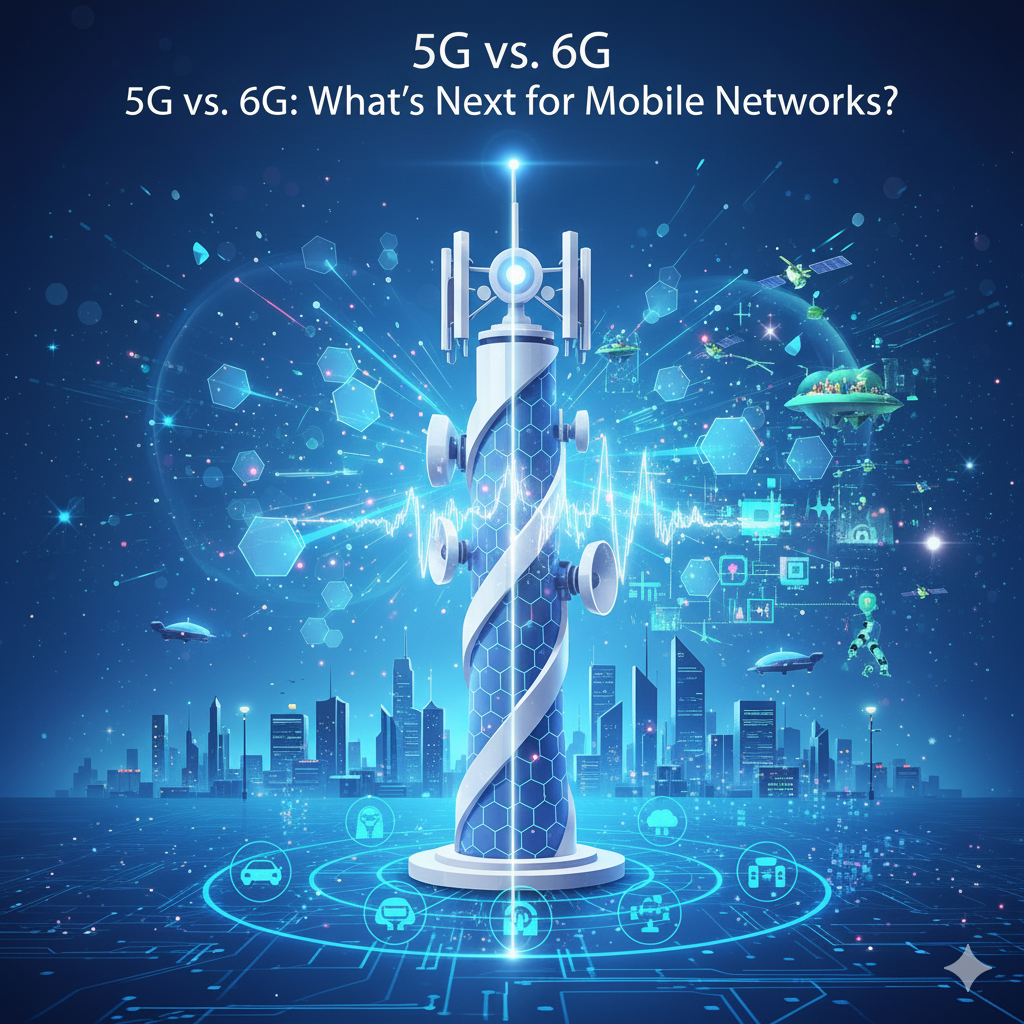
The evolution of mobile networks has been one of the most significant technological advancements of the 21st century. From the early days of 2G and 3G, which revolutionized mobile communications with voice and basic data services, to the introduction of 4G, which brought us high-speed internet and video streaming, the rise of 5G has marked another giant leap in our digital connectivity. But as the world continues to embrace the capabilities of 5G, there’s already talk of its successor: 6G.
In this blog, we will explore the current state of 5G technology, its impact on industries, and the anticipated developments leading toward 6G, including potential applications, challenges, and the transformative benefits that come with it.
The Current State of 5G Technology
In recent years, 5G has transitioned from being a futuristic concept to a reality that is slowly becoming a global standard. By providing higher speeds, ultra-low latency, and increased network capacity, 5G is paving the way for an increasingly connected world. Here’s a quick breakdown of what 5G offers and how it’s changing the landscape:
Key Features of 5G:
- Higher Speeds: 5G can provide download speeds of up to 10 Gbps, which is up to 100 times faster than 4G networks. This enables quicker downloads, seamless streaming of high-definition and 4K videos, and a smoother experience for data-heavy applications like virtual reality (VR) and augmented reality (AR).
- Low Latency: One of the most critical advancements with 5G is ultra-low latency, which is expected to drop to as low as 1 millisecond. This is a game-changer for applications that require real-time responses, such as remote surgeries, self-driving cars, and industrial automation.
- Massive Connectivity: 5G can support up to 1 million devices per square kilometer, making it ideal for the Internet of Things (IoT). The expanded capacity allows for seamless integration of connected devices, from smart homes to industrial IoT, creating a truly connected ecosystem.
- Network Slicing: With 5G, mobile operators can implement network slicing, which allows them to create virtual networks within a physical network. This enables the customization of services for specific use cases, such as low-bandwidth applications or high-bandwidth services like 4K streaming.
Applications and Use Cases of 5G
5G is not just about faster mobile internet; it’s an enabler for new technologies and industries. Below are some areas where 5G is already making an impact:
1. Autonomous Vehicles
Autonomous vehicles rely heavily on real-time data exchange between vehicles, infrastructure, and the cloud. 5G’s low latency allows vehicles to communicate almost instantaneously, which is crucial for safety and navigation. This network infrastructure could enable true vehicle-to-vehicle (V2V) and vehicle-to-infrastructure (V2I) communication, which are necessary for safe, fully autonomous driving.
2. Smart Cities
5G will serve as the backbone for the development of smart cities. By supporting massive IoT networks, it will allow cities to monitor and manage everything from traffic lights to water usage, optimizing urban services and reducing waste. Smart traffic management, energy-efficient buildings, and public safety applications will all benefit from the enhanced capabilities of 5G.
3. Healthcare
5G will enable advancements in telemedicine, allowing for the seamless transfer of large medical files and real-time video consultations. With remote surgeries, doctors will be able to perform procedures from miles away, using robotic arms and AI-assisted technologies, thanks to 5G’s ultra-low latency. Furthermore, remote patient monitoring will be easier, allowing healthcare providers to track patient data in real-time and respond promptly.
4. Industrial IoT (IIoT)
The industrial sector stands to benefit immensely from 5G, especially in smart manufacturing. 5G will enable the communication of sensors, robots, and machines on the factory floor, optimizing production processes. Predictive maintenance, real-time analytics, and automated systems will become the norm as machines can communicate and adjust in real-time without human intervention.
5. Virtual and Augmented Reality (VR/AR)
Both VR and AR are highly bandwidth-intensive technologies, requiring rapid data transmission with little-to-no latency. 5G enables the deployment of immersive experiences in real-time, whether in entertainment, training, or gaming. This will lead to more sophisticated applications in fields like remote training, interactive gaming, and even virtual tourism.
Transitioning to 6G: What’s Next?
While 5G is still in the process of being rolled out globally, the research and development of 6G technology is already well underway. So, what exactly is 6G? And how will it surpass 5G?
Key Features and Improvements of 6G:
- Terahertz Spectrum: While 5G operates primarily in the millimeter-wave spectrum, 6G is expected to tap into the terahertz frequency bands, potentially offering speeds up to 100 times faster than 5G. This could mean download speeds of up to 1 Tbps (terabit per second)—a mind-boggling increase over the capabilities of 5G.
- Advanced AI Integration: 6G networks will integrate artificial intelligence (AI) at a much deeper level. AI will not only optimize network traffic but also enable autonomous decision-making in real-time. This could allow for smarter traffic management, resource allocation, and error correction in the network.
- Holographic Communication: One of the most anticipated applications of 6G is holographic communication, where users can interact in 3D holograms in real-time, rather than just video calls. This will revolutionize both social interaction and business meetings by allowing for more immersive, realistic communication.
- Ultra-Low Latency & Instantaneous Connectivity: While 5G brings latency down to 1 millisecond, 6G aims to bring it closer to zero latency, enabling applications that require immediate communication, such as real-time remote surgeries or instantaneous information sharing.
- Global Connectivity: Unlike 5G, which is being rolled out in phases, 6G aims for universal global connectivity, even in the most remote and underserved areas. This could bridge the digital divide by providing high-speed internet access to regions that have previously been disconnected from the digital world.
Potential Applications of 6G
6G is expected to unlock new applications that we can only begin to imagine today:
1. Holographic Social Interactions
With the ultra-high speeds and ultra-low latency that 6G offers, we could see the rise of holographic social media platforms. Users could interact with each other in fully immersive 3D holograms, changing how we connect and communicate online. Think virtual meetups and real-time interactions that feel like you’re physically present.
2. Real-Time AI Collaboration
6G will enable instantaneous collaboration between human experts and AI-powered systems. In areas such as healthcare, engineering, and creative arts, individuals could work alongside intelligent AI systems in real-time, significantly accelerating problem-solving, innovation, and design.
3. Space Connectivity
6G could facilitate global connectivity even in space. With the ability to support satellite-based networks in low-Earth orbit, 6G could provide seamless communication between Earth and space stations, helping to support the growing needs of space exploration and communication.
4. Autonomous Transportation Networks
While 5G will enable autonomous vehicles to communicate with each other and their environments, 6G will take this a step further. It will enable instantaneous communication between vehicles, road infrastructure, and smart cities, creating fully autonomous, connected transportation networks with no human intervention.
Challenges in Developing 6G
While the potential of 6G is vast, there are several hurdles that need to be overcome before its widespread deployment:
1. Spectrum Management
6G will need to operate at higher frequencies, including the terahertz spectrum. Managing and regulating this spectrum is a major challenge, as it will require new infrastructure and technologies to prevent interference and ensure reliable performance.
2. Energy Consumption
One of the concerns with 5G networks is the increase in energy consumption, and 6G may face similar challenges. The new terahertz frequencies, along with the increased network density, may require significant energy resources, potentially impacting sustainability goals.
3. Security Risks
As connectivity grows and becomes more integrated into every aspect of life, security concerns will only intensify. The complex, decentralized nature of 6G will require advanced cybersecurity measures to prevent malicious attacks, data breaches, and privacy violations.
Conclusion: The Future of Mobile Networks
The transition from 5G to 6G represents the next major leap in mobile network technology. While 5G has already begun transforming industries and enabling new applications, 6G promises to take us even further—into an era of holographic communication, AI collaboration, and global connectivity. However, significant challenges remain, including the management of new frequency spectrums, the energy requirements of advanced networks, and the need for robust security measures.
As the 5G rollout continues and research on 6G intensifies, the potential for mobile networks to drive societal progress is immense. The future of mobile connectivity is on the horizon, and with it, new possibilities for how we work, learn, and interact with the world around us.


Leave a Reply